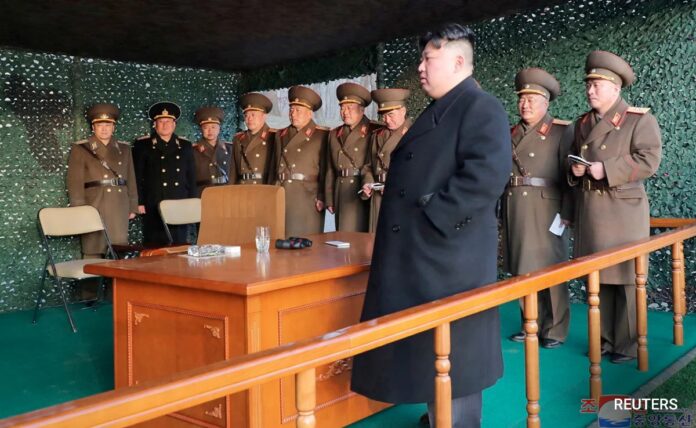| Translate This News In |
|---|
Kim Jong Un, the leader of North Korea, oversaw two days of military exercises “simulating a nuclear counterattack,” which included the launch of a dummy nuclear warhead on a ballistic missile, according to official news agency KCNA on Monday.
The weekend exercises, which were conducted to “let relevant units get acquainted with the procedures and processes for executing their tactical nuclear attack missions,” were met with “satisfaction” from Kim, according to the report.
The exercises, Pyongyang’s fourth military display in a week, coincided with South Korea and the US conducting Freedom Shield, their biggest joint military exercises in five years, which lasted 11 days.
North Korea has frequently threatened to respond with “overwhelming” measures because it sees all such drills as invasion practise.
Both a practise for “launching a tactical ballistic missile tipped with a mock nuclear warhead” and exercises simulating the transition to a nuclear counterattack stance made up the drills on Saturday and Sunday, according to KCNA.
The short-range ballistic missile launched by Pyongyang, according to Seoul’s Joint Chiefs of Staff, travelled 500 miles or 800 kilometres before touching down in the East Sea, also known as the Sea of Japan.
They described it as a “serious provocation” that broke United Nations sanctions and claimed that US and South Korean security were investigating it.
The US military’s Indo-Pacific Command and Japan have both denounced the launch.
In response to the North’s increasing military and nuclear threats—it has recently performed a number of prohibited weapons tests—Seoul and Washington have increased their defence cooperation.
Seoul and Tokyo are now attempting to patch up old rifts and increase security collaboration as a result of Pyongyang’s recent aggression.
Pyongyang conducted its second ICBM launch of the year on Thursday, using the Hwasong-17, its biggest and most potent ICBM.
The ICBM launch came after the Tuesday launches of two short-range ballistic missiles and the Sunday underwater launch of two strategic cruise missiles.
According to the Yonhap news agency, the United States and Japan have asked the UN Security Council to convene an emergency meeting on Monday to discuss the ICBM launch.
According to KCNA, Kim stated that the military forces in North Korea now have “great confidence” as a result of the drills that took place on Saturday and Sunday.
The North “cannot actually deter a war with the simple fact that it is a nuclear weapons state,” he continued, and the nation could only succeed “when the nuclear force is perfected as a means of actually capable of mounting an attack on the enemy.”
North Korea proclaimed itself to be a “irreversible” nuclear power last year, and Kim recently called for a massive increase in weapon production, including tactical nuclear weapons.
This month, Kim also gave the command to the North Korean military to step up training exercises in order to get ready for a “real war”.


















